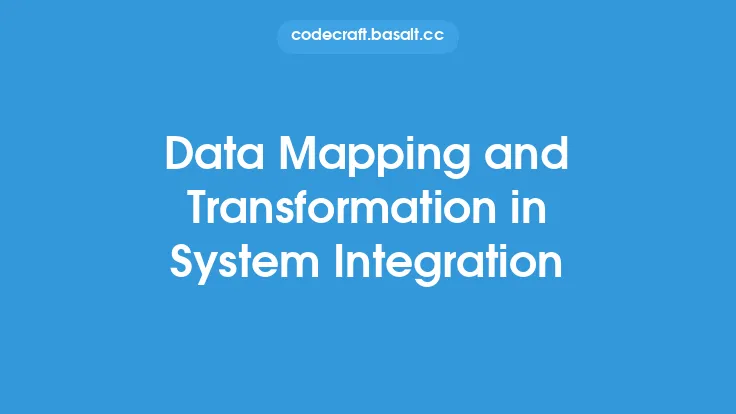Memory management is a critical component of operating systems, and address translation and memory mapping techniques play a vital role in this process. These techniques enable the operating system to efficiently manage memory and provide a layer of abstraction between the physical memory and the applications running on the system. In this article, we will delve into the details of address translation and memory mapping techniques, exploring their concepts, types, and applications.
Introduction to Address Translation
Address translation is the process of converting virtual addresses used by applications into physical addresses that the computer's memory management unit (MMU) can understand. This translation is necessary because applications use virtual addresses, which are not necessarily contiguous or mapped to physical memory locations. The MMU uses a combination of hardware and software techniques to perform address translation, ensuring that applications can access memory without knowing the physical memory layout. There are two primary types of address translation: static and dynamic. Static address translation occurs during the compilation or loading of an application, whereas dynamic address translation occurs at runtime.
Memory Mapping Techniques
Memory mapping techniques are used to map virtual addresses to physical addresses. There are several memory mapping techniques, including paging, segmentation, and paged segmentation. Paging involves dividing memory into fixed-size blocks called pages, which are then mapped to virtual addresses. Segmentation, on the other hand, involves dividing memory into variable-size blocks called segments, which are then mapped to virtual addresses. Paged segmentation combines the benefits of both paging and segmentation, allowing for more efficient memory management. Memory mapping techniques provide a way to manage memory at a fine-grained level, enabling the operating system to optimize memory allocation and deallocation.
Types of Memory Mapping
There are several types of memory mapping, including direct mapping, indirect mapping, and associative mapping. Direct mapping involves mapping virtual addresses directly to physical addresses using a simple offset calculation. Indirect mapping involves using a table or array to map virtual addresses to physical addresses. Associative mapping involves using a combination of direct and indirect mapping techniques to map virtual addresses to physical addresses. Each type of memory mapping has its advantages and disadvantages, and the choice of which one to use depends on the specific requirements of the system and the applications running on it.
Address Translation Techniques
There are several address translation techniques, including base and bounds, paging, and segmentation. The base and bounds technique involves using a base register to store the starting address of a memory block and a bounds register to store the size of the block. The paging technique involves dividing memory into fixed-size blocks called pages and using a page table to map virtual addresses to physical addresses. The segmentation technique involves dividing memory into variable-size blocks called segments and using a segment table to map virtual addresses to physical addresses. Each address translation technique has its advantages and disadvantages, and the choice of which one to use depends on the specific requirements of the system and the applications running on it.
Translation Lookaside Buffer (TLB)
The translation lookaside buffer (TLB) is a cache-like structure that stores recently translated virtual-to-physical address mappings. The TLB is used to speed up the address translation process by reducing the number of times the MMU needs to access the page table or segment table. When the MMU encounters a virtual address, it first checks the TLB to see if the address has been recently translated. If the address is found in the TLB, the MMU can use the cached translation to access the physical memory location. If the address is not found in the TLB, the MMU must access the page table or segment table to perform the translation.
Memory Management Unit (MMU)
The memory management unit (MMU) is a hardware component that performs address translation and memory mapping. The MMU uses a combination of hardware and software techniques to translate virtual addresses into physical addresses and to manage memory access. The MMU is responsible for checking the validity of virtual addresses, translating virtual addresses to physical addresses, and handling page faults and other memory-related exceptions. The MMU is a critical component of modern operating systems, and its design and implementation can significantly impact system performance and security.
Applications of Address Translation and Memory Mapping
Address translation and memory mapping techniques have a wide range of applications in operating systems, including memory management, process isolation, and security. Memory management involves managing the allocation and deallocation of memory for applications, and address translation and memory mapping techniques play a critical role in this process. Process isolation involves isolating applications from each other to prevent them from accessing each other's memory, and address translation and memory mapping techniques can be used to implement process isolation. Security involves protecting the system from malicious applications, and address translation and memory mapping techniques can be used to implement security mechanisms such as access control and memory protection.
Conclusion
In conclusion, address translation and memory mapping techniques are critical components of modern operating systems. These techniques enable the operating system to efficiently manage memory and provide a layer of abstraction between the physical memory and the applications running on the system. The choice of address translation and memory mapping technique depends on the specific requirements of the system and the applications running on it. Understanding address translation and memory mapping techniques is essential for designing and implementing efficient and secure operating systems. By using these techniques, operating systems can provide a robust and efficient memory management system that supports a wide range of applications and use cases.





